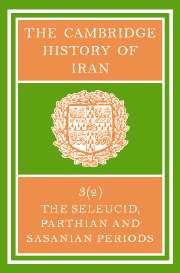Book contents
- Frontmatter
- PART 5 INSTITUTIONS
- PART 6 RELIGIOUS HISTORY
- 22 DEVELOPMENT OF RELIGIOUS THOUGHT
- 23 ZOROASTRIAN RELIGION
- 24 JEWS IN IRAN
- 25 CHRISTIANS IN IRAN
- 26 BUDDHISM AMONG IRANIAN PEOPLES
- 27(a) MANICHAEISM AND ITS IRANIAN BACKGROUND
- (b) MAZDAKISM
- PART 7 ART HISTORY
- PART 8 LANGUAGES AND LITERATURE
- PART 9 BIBLIOGRAPHY
- Bibliography
- Index
- Index of Greek words
- References
22 - DEVELOPMENT OF RELIGIOUS THOUGHT
from PART 6 - RELIGIOUS HISTORY
Published online by Cambridge University Press: 28 March 2008
- Frontmatter
- PART 5 INSTITUTIONS
- PART 6 RELIGIOUS HISTORY
- 22 DEVELOPMENT OF RELIGIOUS THOUGHT
- 23 ZOROASTRIAN RELIGION
- 24 JEWS IN IRAN
- 25 CHRISTIANS IN IRAN
- 26 BUDDHISM AMONG IRANIAN PEOPLES
- 27(a) MANICHAEISM AND ITS IRANIAN BACKGROUND
- (b) MAZDAKISM
- PART 7 ART HISTORY
- PART 8 LANGUAGES AND LITERATURE
- PART 9 BIBLIOGRAPHY
- Bibliography
- Index
- Index of Greek words
- References
Summary
INTRODUCTION
Within Iran, during the period of nearly 1,000 years which separates the Greek and Islamic conquests, successive stages of religious history are interlocked in a manner scarcely paralleled earlier or later. Links are also to be found connecting Iran as a geographical focus with adjoining civilizations, and within the various strands and levels of the structures that can be detected.
After the Jewish diaspora, it was the religion of the Greek polis which appeared alongside and among the religions of those peoples which had become Iranian by the beginning of the first millennium b.c., but had been only semi-homogenized by the reforms of Zoroaster and the religious policies of the Achaemenians. As a result, the influence of Hellenistic religion, though less marked within Iran itself, forms an integral part of Iranian religious history, extending directly for half a millennium and indirectly for considerably longer. This raises the question of what Iranian features, in the stricter sense of the word, were embodied in this religion, not only in Iran itself but also beyond its borders.
The Arsacid kingdom, which appeared in the middle of the 3rd century b.c., alongside the Bactrian and Seleucid dominions and advanced principally at the expense of the latter, brought with it, or Stimulated, a rebirth of Iranian religious awareness in ethnic, linguistic, cultural and national terms. During this process, not only were older Zoroastrian traditions re-adopted but the relationship of the indigenous religions to the alien ones entered a new phase.
- Type
- Chapter
- Information
- The Cambridge History of IranSeleucid Parthian, pp. 817 - 865Publisher: Cambridge University PressPrint publication year: 1983



